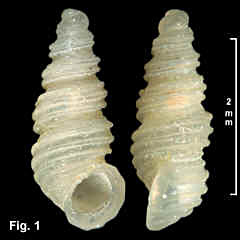|
|
RISSOIDAE |
|
|
|
Lironoba australis (Tenison-Woods, 1877) Description: Shell tall and slender, spire weakly convex. Protoconch of 1 whorl, with distinct junction with teleoconch. Teleoconch up to 5 whorls. Whorls sculptured with strong spiral cords, 2 on first 2 whorls, 3 on latter whorls; further 3 whorls on base of last whorl. No axial sculpture. Aperture ovate, anterior canal broad, very weakly channelled posteriorly. Outer lip of aperture with strong varix externally. Umbilicus absent. Shell colourless translucent becoming opaque white with age. Size: Up to 3.5 mm long, commonly about 2.5 mm. Distribution: Endemic to Australia: Sydney, NSW, southwards and around southern Australia, to South Australia, including Tasmania. Habitat: In the Australian Museum collection empty shells are common from beach washup, and there are a few records down to 33 m. Living specimens are common from intertidal algae and stone washings. However, May (1921) reported it from 100 fathoms in Tasmania, and Cotton (1946) reported it down to 200 fathoms in South Australia. Synonymy: This was known by the replacement name Rissoa tenisoni (Tate, 1899), which was assigned to avoid homonymy, but it is unnecessary with the current generic placement. Remarks: The Australian Museum collection has only two lots from NSW; off Sydney, 79 m; Green Cape, near Eden, algae washings, 2-4 depth. Fig. 1: Kelso, Tasmania (C.213561) |
|
